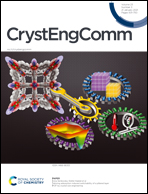Metal–organic frameworks derived from a semi-rigid anthracene-based ligand and sulfonates: proton conductivity and dye degradation studies†
Abstract
Solvothermal reaction of cobalt nitrate/copper nitrate with a semi-rigid 1,1′-(anthracene-9,10-diylbis(methylene))bis(pyridin-1-ium-4-olate) (L = AHP) ligand and disulphonic acid [1,5-naphthalenedisulfonic acid (1,5-NDS)/2,6-naphthalenedisulfonic acid (2,6-NDS)] resulted in the formation Co(II)/Cu(II) containing metal–organic frameworks (MOFs). These MOFs have been structurally characterized by different methods including single crystal X-ray diffraction. The structural analysis revealed that the number of coordinated AHP ligands is different in different MOFs and each AHP ligand is actively involved in the formation of a one-dimensional chain. The presence of 1,5-NDS/2,6-NDS either in a coordinated or free form (lattice) plays an important role in increasing the dimensionality of the frameworks. The characterized MOFs have been tested for their proton conductivity and dye degradation properties. The presence of free water and 1,5-NDS in the cavity of MOF4 encouraged us to perform proton conductivity measurement. MOF4 seems to maintain its framework structure in various humid environments and ensures smooth conduction pathways mediated by water molecules. Depending on the temperature and humidity levels, this MOF showed moderate to high proton conductivity (6.96 × 10−4 to 1.95 × 10−3 S cm−1). The above synthesised MOFs show the degradation of methylene blue in the presence of hydrogen peroxide (H2O2). The increase of degradation activity in the presence of H2O2 indicates the formation of hydroxyl radicals in the reaction process.

- This article is part of the themed collection: Supramolecular & Polymorphism


 Please wait while we load your content...
Please wait while we load your content...